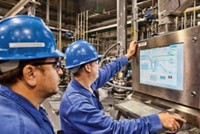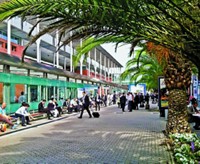Advertisement
Grab your lab coat. Let's get started
Welcome!
Welcome!
Create an account below to get 6 C&EN articles per month, receive newsletters and more - all free.
It seems this is your first time logging in online. Please enter the following information to continue.
As an ACS member you automatically get access to this site. All we need is few more details to create your reading experience.
Not you? Sign in with a different account.
Not you? Sign in with a different account.
ERROR 1
ERROR 1
ERROR 2
ERROR 2
ERROR 2
ERROR 2
ERROR 2
Password and Confirm password must match.
If you have an ACS member number, please enter it here so we can link this account to your membership. (optional)
ERROR 2
ACS values your privacy. By submitting your information, you are gaining access to C&EN and subscribing to our weekly newsletter. We use the information you provide to make your reading experience better, and we will never sell your data to third party members.
Business
Outlook Remains Cautious For 2006
Jaded industry participants are wary about predicting an upturn for custom chemicals
by Ann M. Thayer
February 13, 2006
| A version of this story appeared in
Volume 84, Issue 7
COVER STORY
Outlook Remains Cautious For 2006
The dynamics of the custom chemicals market are pretty well established, industry participants say, and include overcapacity and consolidation. The past five years have been tough, especially for the large European fine chemicals companies, most of which are undergoing substantial change. A technology-based focus on niche markets has made the situation better for some firms. Meanwhile, competition from Asia has increased in scope and in quality (see page 17).
More than 70% of active pharmaceutical ingredients (APIs) and advanced intermediates produced worldwide go into pharmaceuticals, reports the Chemical Pharmaceutical Generic Association, with the rest going to veterinary products and agrochemicals. Thus, the fortunes of API producers are tied primarily to those of drug developers, a group that has been under severe pressure, and business from the major drug companies has waned.
Drug firms make and consume internally about 60% of all APIs and intermediates. The remaining merchant market for APIs, which was worth about $28 billion in 2004, is expected to grow an average 5.7% per year to 2009; APIs for branded drugs will grow a bit more slowly; those for generics, somewhat faster; and for the biopharmaceuticals sector, nearly three times as fast.
As more drugs go off patent, the demand for APIs for generics grows, but producers mainly in China and India are taking advantage of this opportunity. A related issue is that API producers are seeing their overcapacity problems exacerbated by declining product volumes. "The drugs going off patent typically have higher doses than the new ones being launched," points out Nick Hyde, global business director for Dow Chemical's Dowpharma unit. "The supply-and-demand balance in fine chemicals is driven by volume as much as value."
Even worse, the number of new compounds being launched as drugs is less than half of what it was a decade ago. Approvals of new drug substances hit a new low in 2005 because of delays and outright failures. As a result, outsourcing by many drug firms has decreased. On the plus side, the number of new drugs in development is reportedly higher than it has ever been.
Many API providers tell C&EN they see a promising "peak in the pipeline," or an increase in the number of candidates in Phase II clinical trials that, they hope, will convert into a need for more APIs than drug companies can manufacture on their own. The problem has always been translating these numbers into late-stage prospects and then marketing approvals. If these compounds actually make it, the custom manufacturing industry could see a significant upturn in three or four years.
"If the success rates are better than what they have been over the past few years???and that remains a big question mark???then the capacity utilization problems will be over," comments Michael J. Fernandes, the new executive director for custom manufacturing at Nicholas Piramal, in Mumbai, India.
A recent study from Tufts Center for the Study of Drug Development is somewhat more optimistic that drug developers can reverse the downward trend (C&EN, Jan. 23, page 9). It also suggests that biotech companies will increasingly seek fast-track designation to help accelerate their clinical development programs.
Many industry participants see the biopharmaceutical sector as having the strongest pipeline and offering the most promise for innovation. API suppliers with the right capabilities also find the market attractive: The entry barriers can be high, and there are very few players versus hundreds of fine chemicals companies doing traditional synthesis.
"I don't expect the market to necessarily turn around in the near term," Fernandes says. "My sense is that there will be significant amounts of movement within the market as opposed to the whole market growing significantly overall." This includes shifts in market share, in outsourcing by pharmaceutical companies, and in how suppliers capture any outsourced business.
"If you are offering something that is valued by customers, you will be seeing above-market growth," Hyde believes. This means, in turn, that others will experience below-average growth. "I think the trend of continued rationalization among those companies without differentiation will continue," he says.
Avecia and Rhodia have exited the business while many companies are restructuring. Others are seeking opportunities wherever they can find them. At best, many fine chemicals company managers muster up "cautious optimism" as their comment on the business' outlook.
Lonza, the industry leader and a bellwether of sorts, has reported results for 2005. Sales in the company's exclusive synthesis and biopharmaceuticals unit increased 47% to $695 million and operating income more than doubled. By year-end, its exclusive synthesis capacity utilization rate was 75%, up a bit over 2004, due to a slightly higher number of projects.
Lonza says the substantial improvement in 2005 was mainly a result of high utilization of large-scale bioreactors and a strong project pipeline for mid- and small-scale fermentation units. Biopharmaceutical projects were up by about 20% compared with 2004. To meet demand, the company has initiated many expansion projects.
Sumitomo Chemical, with its manufacturing base in Japan, has been pushing to expand the breadth of its business, says Simon F. Sellers, president of Sumitomo Chemical America's fine chemicals division. "We've seen very significant growth in revenues from the U.S. and appreciable growth in Europe, in large part from new customers," he says.
At the annual CPhI meeting in Madrid in November 2005, Clariant said it was positioned to take advantage of an upswing in outsourcing. Three years ago, the company decided to focus on its expertise in organic chemistry and its supply capabilities in Europe and the U.S. "Business prospects are healthy and going to be healthier," said Norbert Dieterich, head of Clariant's pharmaceutical fine chemicals business.
Antonio Germani, director for pharma solutions at BASF, says 2005 was a good year for BASF's custom manufacturing business and for Orgamol, which it acquired late last year. If the combined business follows the same trends, he says, 2006 could turn out well. He cautions, however, that it's difficult to make predictions with any certainty so early in the year.
Last year was a good year for Pfizer CentreSource, says President Michael J. Kosko, despite growing Asian competition. Although Pfizer's API business has been under some pressure, projects based on its high-containment capabilities have continued to grow. Custom manufacturing operations also look promising, and a new outsourcing strategy in its steroids business is aimed at recapturing market share.
Small technology-focused companies, or even similar units within larger firms, see a somewhat different marketplace, and many are upbeat. When it comes to smaller operations or niche technologies, such companies tell C&EN there isn't a problem filling capacity, since many projects being outsourced require complex or specialized chemistries.
Large pharmaceutical customers more often look for strategic relationships, compared with the tactical needs of small or virtual drug companies, explains David Rowles, managing director for molecular development at Excelsyn. Launched in 2004, the company has seen its laboratory services and other businesses grow dramatically over the past year. He says Excelsyn is on target to reach a goal of 50% growth, or about $30 million in revenues, for the fiscal year ending in May.
"Small pharmaceutical and virtual drug companies are taking hold, and as a result, we now have a lot of research-focused customers without any production capabilities relying on us," says Aslam A. Malik, president of Ampac Fine Chemicals, formerly owned by Aerojet. He says that 2005 brought in new business and stable sales. "We started adding more capacity in 2005 and have a lot of business lined up for 2006."
In the years from 2000 to 2005, many projects were in Phase I or II trials, and customers needed small quantities of materials, explains Pierre Charrier, chief operating office of Minakem, the former SEAC business. "We have seen more inquires about projects moving into Phase II or Phase III that need larger quantities, and that's a good sign," he says. "But in this business we have to be very careful. Even once a product has been launched, there is always risk associated with being a supplier."







Join the conversation
Contact the reporter
Submit a Letter to the Editor for publication
Engage with us on Twitter